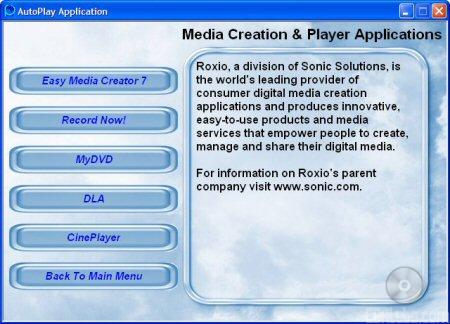Installing the PX-750A in our test computer took only a couple of minutes. After taking Plextor's new DVD writer out of the box, I left the jumper set to master and installed it on the secondary IDE chain by connecting the IDE cable and power connector. When I turned on the computer the BIOS detected it as a drive supporting UDMA 66. After making sure that the DMA was enabled in the Device Manager, I was ready to start installing the software.
Software Installation:
As I mentioned earlier, the PX-750A comes with a DVD full of software from Roxio and Sonic. If you have autorun enabled on your computer, the menu shown below will appear when you insert the disc. From here you can access the manual, register your drive or install the bundled software.
Clicking on the "Software" button will bring up the menu pictured below. Simply click the name of the application you want to install, and its setup program will start up automatically.
If you have installed Roxio's Easy Media Creator before, you're probably already familiar with the installation process. All you need to do is choose what language you want and select your installation options.By default the setup program will install the entire suite onto your computer. If you don't want to install everything, select the custom installation. From here you can choose just the components you want.
Installing the rest of the bundled software is pretty straightforward. In most cases, it's as simple as choosing the location where you want to install the program, clicking next a few times and waiting for the setup program to copy the files over. After rebooting you'll be ready to to do things like edit your videos and burn them to disc.
Documentation:
While the drive we received from Plextor did not come with any printed documentation, there was a copy of the manual on the CD in electronic format. Similar to the ones included with Plextor's other DVD writers, the manual starts out by getting the user familiarized with their new DVD writer. The first section goes over the PX-750A's capabilities, features and system requirements. Plextor has also provided some pretty good diagrams showing all of the different buttons and connectors located on the front and back of the drive. Everything is labeled clearly and the functions of each are easy to understand.
The next section of the manual jumps right into the physical installation of the PX-750A. It starts out by going over how to open up your computer and determine your existing IDE configuration. If you're not sure about how to configure your computer, Plextor has provided a few examples along with the corresponding jumper settings. For more experienced users, there are also a few recommended configurations that will get you up and running quickly. The rest of the installation section walks you through the process of mounting the drive in your computer and hooking up the cables.
The manual finishes up by going over the basic operation of the PX-750A. Along with information on how to use and maintain the drive, there is a short list of frequently asked questions. Last but not least, Plextor has also provided a comprehensive list of specifications as well as a list of recommended media.
Like the other Plextor drives I've reviewed, the PX-750A was very easy to install. I had no problems getting the drive or the software installed and working. For those that might need a little help, the documentation Plextor has provided is quite good and contains a lot of information that should satisfy the needs of both novices and professionals alike. With this in mind, the PX-750A gets a 9 out of a possible 10 for the installation portion of this review.




